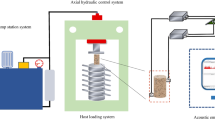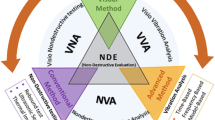Abstract
Composite materials are widely used in aerospace, automobiles, ships, and other fields. However, they are easily affected by external factors, and these damages may lead to structural performance degradation or even failure. The method based on stress wave analysis can assess the damage degree and location of the structure by applying a short pulse or modulated load on the structure and using sensors to capture the propagation and reflection of stress waves. In this paper, through the study of the formation, propagation, and interaction of stress waves with materials, with the help of the characteristics and damage mechanism of composite materials and the analysis of the application process steps of stress waves in damage monitoring, combined with the discussion of damage location technology and damage severity assessment methods, and based on the final data results, the following conclusions are drawn: the greater the damage of the composite material is, the more obvious the attenuation of the amplitude of the stress wave and the greater the change of the propagation velocity is; at the same time, the comprehensive average improvement of the identification accuracy of the composite material structure damage monitoring system compared with the traditional method is about 10%. This shows that the stress wave analysis technology can detect tiny damage sensitively and can provide high-precision damage identification results.






Similar content being viewed by others
Data availability
All data generated or analyzed during this study are included in the manuscript.
References
Curtin T, Adey R, Peratta A (2022) New material damage insight using atmospheric corrosion modeling. Mater Perform Appl Inf Protect Mater 61(10):38–42
Yang Q, Liu P, Ge Z et al (2020) Self-sensing carbon nanotube-cement composite material for structural health monitoring of pavements. J Test Eval 48(3):1–13
Denghong X, Yong G (2020) Damage monitoring of carbon fiber reinforced silicon carbide composites under random vibration environment by acoustic emission technology. Ceram Int 46(11):18948–18957
Tan K, Postel V, Liu Y et al (2022) Development of a photomicroscope method for in situ damage monitoring under ultrasonic fatigue test. Int J Struct Integrity 13(2):237–250
Zhuang TY, Tang CY, Dan JB (2021) Monitoring and diagnosis of the health status of the reducer of the dry quenching hoist based on stress wave analysis technology. China Instrum Meters 2021(5):48–51
Sun L, Xu S, Wei X et al (2020) Application and research progress of stress wave non-destructive testing technology for wood. World For Res 33(6):39–43
Liu X, Yan G, Tang J (2021) Research on damage probability imaging of composite cylindrical shell structures based on stress waves. Compos Mater Sci Eng (09):5–11
He Y, Liu S, Bai Y et al (2023) Mechanical stress wave detection and analysis of Cascode type GaN HEMT devices based on acoustic emission. Chin J Electr Eng 43(2):750–760
Hui P, Li Y, Wang R et al (2021) Quantitative detection of GFRP material loss defects by microwave reflection. Sens Microsyst 40(7):110–113
Xing X, Li S, Zhou Y et al (2022) Research progress on the application of acoustic emission technology in wood material damage monitoring. World For Res 35(6):63–68
Modanli M, Faraj BM, Ahmed FW (2020) Using matrix stability for variable telegraph partial differential equation. Int J Optim Control Theor Appl (IJOCTA) 10(2):237–243
He D, Wei J, Wang W et al (2023) Detection and analysis of insulation stress waves in power electronic device packaging under interface defects and aging conditions. J Electr Eng Technol 38(3):610–621
Chai S, Zhou T, Tian W et al (2022) Analysis of stress wave propagation characteristics in structural planes considering rock mass stress. Geotech Mech 43(01):184–192
Huang J, Chen M, Ma N et al (2021) Analysis of stress wave transmission law in cable-stayed bridge structural systems. Transp World 00(11):31–34
Yang U, Xu Y, Chen L (2022) Stress waves and failure in composite material cylinders. J Gun Launch Control 043(002):1–6
Tang L, Li Y, Bao Q, Hu W, Wang Q, Su Z, Yue D (2023) Quantitative identification of damage in composite structures using sparse sensor arrays and multi-domain-feature fusion of guided waves. Measurement 208:112482
Delgado M, Eduardo L, Rodellar Benedé J, Vehí CJ (2010) A review of impact damage detection in structures using strain data. Int J COMADEM 13(1):3–18
Chou Y, Liu W, Qiao X et al (2021) Research status on damage mechanism and vibration reduction and isolation of building structures under traffic vibration environment. J Earthq Eng 043(003):654–662
Zhang Z, Feng J, Zhang M et al (2020) Analysis of damage development of tunnel lining structure under train load based on the toughness characteristics of fiber reinforced concrete. J Rock Mech Eng 039(012):2483–2504
Hu M, Sun B, Gu B (2022) Characteristics of multiple stress wave impact damage in 3D braided composite materials. Aerospace Manuf Technol 65(16):126–134
Lu L, Yu H, Qiao P (2021) Review of non-destructive testing of concrete based on stress wave propagation mechanism. J Mech Q 42(2):197–216
Liu X, Cai G, Zhang C (2021) Damage monitoring of GFRP tube confined carbon fiber concrete composite columns. Piezoelectr Acoust 43(3):395–398
Jiang T, Fang L, Liang S (2022) Experimental study on monitoring the loosening and damage of high-strength bolts in flange connections based on piezoelectric ceramics. China Foreign Highway 042(001):95–100
Funding
This work was supported by Shaanxi Province two chains integration of cultural heritage key special2023, Shaanxi Province key research and development plan.
Author information
Authors and Affiliations
Contributions
HX contributed to methodology, project administration, manuscript editing; software, validation; visualization, manuscript review and editing; LJ contributed to design framework, resources, and validation.
Corresponding author
Ethics declarations
Conflict of interest
There is no conflict of interest among the authors.
Additional information
Publisher's Note
Springer Nature remains neutral with regard to jurisdictional claims in published maps and institutional affiliations.
Rights and permissions
Springer Nature or its licensor (e.g. a society or other partner) holds exclusive rights to this article under a publishing agreement with the author(s) or other rightsholder(s); author self-archiving of the accepted manuscript version of this article is solely governed by the terms of such publishing agreement and applicable law.
About this article
Cite this article
Xiao, H., Jiajun, L. Damage monitoring of composite material structures based on stress wave analysis. Electr Eng 106, 1391–1401 (2024). https://doi.org/10.1007/s00202-023-02164-z
Received:
Accepted:
Published:
Issue Date:
DOI: https://doi.org/10.1007/s00202-023-02164-z




